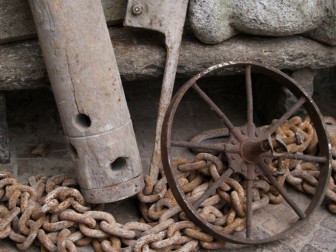Arts and crafts work-shops where traditional products are made with skills handed down from generation to generation are still reasonably common around the province.
In Valtrompia there are many artisans who practise the ancient art of metal engraving which has been performed there since 1500 on armour and swords and which helped to make the Venetian army famous. Today, the craftsman traces the design onto the metal parts of hunting rifles using a hammer and chisel creating a work of art out of each item.
In Franciacorta the fine wrought-iron gates to large houses testify to the diffusion of this traditional art. Wrought-ironwork is still practised today but not perhaps all done by hand.

The production of iron objects is also linked to Valcamonica, particularly to Bienno. Originally established during the 17th century, some are still in operation, but their products were dedicated to functionality rather than beauty-hoes, buckets, shovels and other household and agricultural objects.
Montisola on Lake Iseo is still the centre for net-making.
The skills of weaving threads of silk, linen, hemp and cotton and then dyeing the results the colour of rust with chestnut skins were taught by mother to daughter for centuries.
Marquetry and wood-working is typical of the mountain areas of the Brescian valley which has produced an artistic heritage visible in the village churches. Woodworking is still popular and can be seen in the production of everyday objects such as bowls, walking sticks, clogs, chopping boards and ladles etc., especially in Valcamonica at Darfo Boario Terme and Ponte di Legno where it is not difficult to find shops dedicated to wooden articles.
Typical of Valcamonica are “pezzotti” of Monno, woven on 18th century frames.
The local fishermen’s boat, the “naèc”, is still made by hand in the small yards of Monte Isola.
It is a long, tapered boat very functional for fishing and different to those in other lake areas around Italy as it is based on a sea-going design.
The story goes that the creator of this boat was a carpenter who had been freed from Venetian gaol where he had been imprisoned for stealing secret designs of Venetian boats. He adapted the design of a gondola to fishing purposes and the “naèc” was born.
Besides hand-working of pewter and copper at Bagolino, there are still crafts alive relating to the “Bagolino Carnival”. For example, the clogs (“sgalber”) are engraved and the aprons (“gede”) woven on a frame, both by hand.
Photo: Maurizio Zanetti
